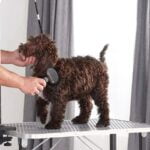Table of Contents
Puppies naturally explore the world with their mouths, leading to chewing behavior that can be destructive if not properly managed. Understanding and addressing chewing behavior in puppies is crucial for protecting your belongings and ensuring your pet develops good habits. Here are 10 effective tips for addressing chewing behavior in puppies.

1. Provide Appropriate Chew Toys
One of the best ways to address chewing behavior in puppies is to provide them with appropriate chew toys. These toys can help satisfy their need to chew and keep them occupied. Choose durable toys that are safe for puppies. For recommendations on the best chew toys, visit AKC Best Chew Toys for Puppies.
2. Use Positive Reinforcement
Positive reinforcement is key to training your puppy to chew on appropriate items. Praise and reward your puppy when they chew on their toys instead of furniture or other household items. This helps them associate good behavior with positive outcomes. For tips on positive reinforcement, see PetMD Positive Reinforcement.
3. Puppy-Proof Your Home
Puppy-proofing your home is essential to prevent your puppy from chewing on inappropriate items. Keep shoes, cords, and other tempting objects out of reach. Use baby gates to limit your puppy’s access to certain areas of the house. For more on puppy-proofing, visit The Spruce Pets Puppy-Proofing.
4. Supervise and Redirect
Supervise your puppy closely, especially during the initial training period. If you catch your puppy chewing on something inappropriate, calmly redirect them to a suitable chew toy. Consistency is crucial for this technique to be effective. For more on supervision and redirection, see Petfinder Puppy Chewing.
5. Exercise and Mental Stimulation
Ensure your puppy gets plenty of exercise and mental stimulation. A tired puppy is less likely to engage in destructive chewing. Incorporate regular playtime, walks, and interactive toys into your puppy’s daily routine. For exercise ideas, visit AKC How to Exercise a Puppy.
6. Crate Training
Crate training can help manage your puppy’s chewing behavior. When you cannot supervise your puppy, place them in a crate with safe chew toys. This keeps them secure and prevents destructive chewing. For crate training tips, visit ASPCA Crate Training.
7. Use Deterrent Sprays
Deterrent sprays can be effective in discouraging your puppy from chewing on specific items. These sprays have an unpleasant taste that deters puppies from chewing. Apply the spray to furniture and other items you want to protect. For more on deterrent sprays, see The Spruce Pets Best Dog Taste Deterrents.
8. Establish a Routine
Establishing a consistent daily routine helps reduce your puppy’s anxiety and the likelihood of destructive chewing. Set regular times for feeding, play, training, and rest. A predictable routine helps your puppy feel secure and less inclined to chew out of boredom or stress. For tips on establishing a routine, visit PetMD Establishing a Routine.
9. Address Teething Pain
Puppies often chew to relieve teething pain. Provide teething toys or frozen washcloths to soothe their gums. Be patient and offer plenty of appropriate chew items during this phase. For more on managing teething pain, see AKC Puppy Teething and Nipping.
10. Be Patient and Consistent
Addressing chewing behavior in puppies requires patience and consistency. Training takes time, and setbacks are normal. Stay consistent with your training techniques and continue to reinforce good behavior. For more on being patient and consistent, see ASPCA Teaching Your Dog Not to Chew.
Additional Resources on Addressing Chewing Behavior in Puppies
For more detailed guides and support, check out these trusted resources:
Addressing chewing behavior in puppies is an important part of their training and development. With patience, consistency, and the right techniques, you can help your puppy develop good chewing habits and protect your belongings. For more resources on puppy training and care, visit our Puppy Training section.
FAQs
Why do puppies chew on everything?
Puppies chew to explore their environment, relieve teething pain, and alleviate boredom. It’s a natural behavior that needs to be managed with appropriate chew toys and training.
How can I stop my puppy from chewing on furniture?
Provide appropriate chew toys, supervise your puppy, and use deterrent sprays on furniture. Redirect their chewing to acceptable items and reward good behavior.
Is it normal for puppies to chew a lot?
Yes, chewing is a normal behavior for puppies, especially during the teething phase. Providing suitable chew toys and proper training can help manage this behavior.
What are the best chew toys for puppies?
Durable, non-toxic chew toys designed for teething puppies are the best. Look for toys that are safe, engaging, and appropriate for your puppy’s size and chewing strength.
How long does the teething phase last in puppies?
Puppy teething typically lasts until they are about six months old. During this time, they will lose their baby teeth and grow their adult teeth, leading to increased chewing.
Can I use punishment to stop my puppy from chewing?
Punishment is not recommended, as it can lead to fear and anxiety. Positive reinforcement and redirection are more effective techniques for managing chewing behavior in puppies.
Conclusion
Addressing chewing behavior in puppies is an essential aspect of their training and development. By following these tips and using positive reinforcement, you can help your puppy develop good chewing habits and protect your belongings. Regular practice, patience, and consistency are key to achieving success in managing your puppy’s chewing behavior.
Get LIFETIME ACCESS to “My Private Prompt Library”: https://bit.ly/MTSPromptsLibrary
Looking for a custom GPT? or SEO services for your website? Hire me on Fiverr: https://bit.ly/Hire_me_as_a_Freelancer
============================================
Get LIFETIME ACCESS to “My Private Prompt Library”: https://bit.ly/MTSPromptsLibrary











